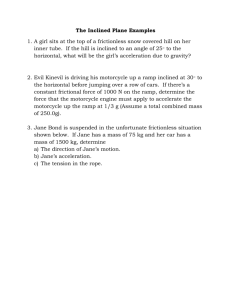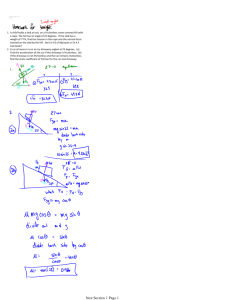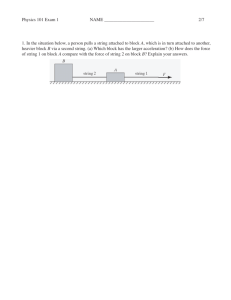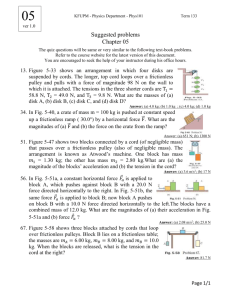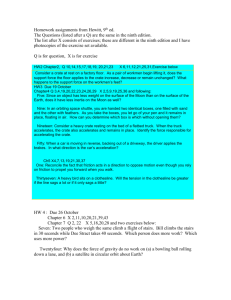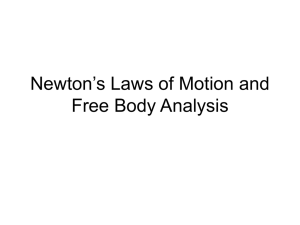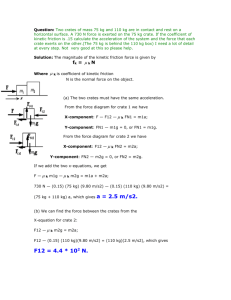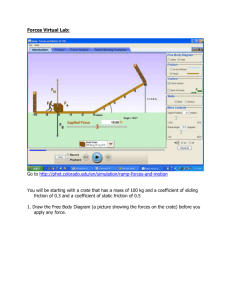Physics 103-02 Exam II 16 October 1992
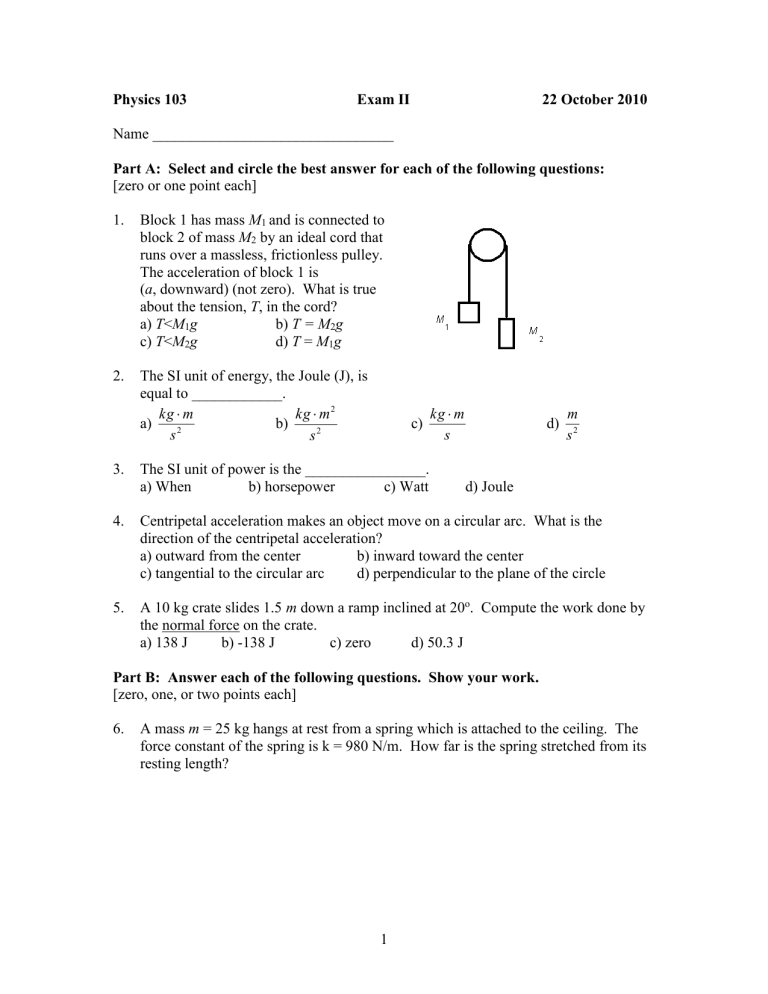
Physics 103 Exam II 22 October 2010
Name ________________________________
Part A: Select and circle the best answer for each of the following questions:
[zero or one point each]
1. Block 1 has mass M
1 and is connected to block 2 of mass M
2
by an ideal cord that runs over a massless, frictionless pulley.
The acceleration of block 1 is
( a , downward) (not zero). What is true about the tension, T , in the cord? a) T < M
1 g b) T = M
2 g c) T < M
2 g d) T = M
1 g
2. The SI unit of energy, the Joule (J), is equal to ____________. kg
m a) b) s
2 kg
m
2 s
2 c) kg
m s m d) s
2
3. The SI unit of power is the ________________. a) When b) horsepower c) Watt d) Joule
4. Centripetal acceleration makes an object move on a circular arc. What is the direction of the centripetal acceleration? a) outward from the center b) inward toward the center c) tangential to the circular arc d) perpendicular to the plane of the circle
5. A 10 kg crate slides 1.5 m down a ramp inclined at 20 o . Compute the work done by the normal force on the crate. a) 138 J b) -138 J c) zero d) 50.3 J
Part B: Answer each of the following questions. Show your work.
[zero, one, or two points each]
6. A mass m = 25 kg hangs at rest from a spring which is attached to the ceiling. The force constant of the spring is k = 980 N/m. How far is the spring stretched from its resting length?
1
7.
A spring ( k = 1000 N/m) is initially compressed by 0.25 m. A mass, m = 10 kg, is attached to the end of the spring. Compute the work done by the spring when the mass moves from the spring being compressed by 0.25 m to being stretched by
0.25 m.
8. A square shop sign is hung from 2 ideal cords attached to the sign’s upper corners. The two cords make the same 45 o
angle with the vertical.
The mass of the sign is 2.00 kg. Compute the tension is each cord.
9. A Ferris wheel has a 15 meter radius. The cars move in a vertical circle at a constant speed of v = 8.00 m/sec. A passenger in one of the cars has a mass of 70 kg (weight of 686 N). How heavy does the passenger feel at the car’s lowest point during his or her ride?
2
10. On the Moon, where g = 1.55 m/sec
2
, a rock with mass, m , is dropped from the rim of a crater. The mass falls a distance of 20.0 m to the crater floor. How fast is the moon rock moving just before hitting the crater floor?
11. A crate slides at a constant speed down an inclined ramp. If the ramp is inclined
20 o above the horizontal, and the mass of the crate is M = 200 kg, what is the magnitude of the frictional force on the crate?
12. The crate in problem 11 slides 1.5 m down the ramp. Compute the works done by gravity and by friction on the crate.
3
13. A car drives on a flat, circular track whose radius is 300 m. The coefficient of friction between the tires and the road surface is
s
= 0.150. How fast can the car move around the track without sliding?
14. A 3.00 kg book is given a shove (initial speed v o
= 0.50 m/s) along a counter top.
The coefficient of kinetic friction is
= 0.200. Calculate how far the book slides before it comes to rest.
15. An object of mass
F
1
2 N iˆ
2 N jˆ , m
= 15 kg is acted upon by three forces. Those forces are:
F
2
3 N iˆ
3 N jˆ , and F
3
5 N iˆ . Evaluate the acceleration of the object.
4
Part C: Work the following problem. Show your work, and use words and phrases to describe your reasoning.
[10 points]
16. In the situation shown in the diagram, find (a) the tension in the cord and (b) the acceleration(s) of the masses (not necessarily in that order). The cord is ideal, and the incline and the pulley are frictionless. If the inclined surface were not frictionless, which way would the frictional force point?
The “work” that you show should include free-body diagrams and coordinate axes.
[ M
1
= 100 kg; M
2
= 45 kg, and
= 30 o
]
M
1
T
M
2
5
Vectors:
A
A x x
ˆ
A y y
ˆ
A z z
ˆ
Kinematics:
C
A x
= A
B
x
+ B
A x
B x x
A y
B y
A z
B z
AB cos
r
x
ˆ y
ˆ
r
r f
r i
Constant acceleration: x
x o
v ox t
1
2 a x t
2 v x
v ox
a x t v x
2 2 v ox
2 a x
x
x o
radial acceleration:
Quadratic formula
Newton’s
2nd Law
Friction a r x
v
2 r
b
F x
ma x
F f
N b
2
4 ac
2 a
F s
k
x
x o
or F x
kx Restoring
Force
Work &
Energy dW
F
d r
A
A
A
2 x
A
2 y
A z
2
1
2
C y
= A y
+ B y v
d r
dt
v
v x x
ˆ v y
r
t
Earth’s gravity:
v x
v f
2 v i x
x o
v x
t
Circumference of a circle
F y
ma y
W
K
ˆ
a a a
C z
= A z
+ B z
a
d v
a x x
a y dt
a
v
t g = 9.8 m/sec
2
C = 2
r
F
z ma z
K
1
2 mv
2
6
